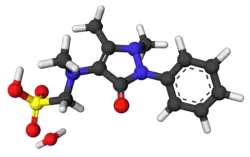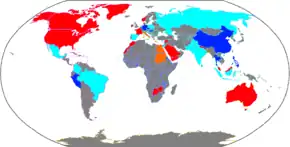Metamizole
 | |
 | |
| Names | |
|---|---|
| Trade names | Novalgin, others[1][2] |
| Other names | Dipyrone (BAN UK, USAN US) |
IUPAC name
| |
| Clinical data | |
| WHO AWaRe | UnlinkedWikibase error: ⧼unlinkedwikibase-error-statements-entity-not-set⧽ |
| Pregnancy category |
|
| Routes of use | By mouth, IM, IV, rectal |
| External links | |
| AHFS/Drugs.com | International Drug Names |
| Legal | |
| Legal status |
|
| Pharmacokinetics | |
| Bioavailability | 100% (active metabolites)[4] |
| Protein binding | 48–58% (active metabolites)[4] |
| Metabolism | Liver[4] |
| Elimination half-life | 14 minutes (parent compound; parenteral);[3] metabolites: 2–4 hours[4] |
| Excretion | Urine (96%, IV; 85%, oral), faeces (4%, IV).[3] |
| Chemical and physical data | |
| Formula | C13H17N3O4S |
| Molar mass | 311.36 g·mol−1 |
| 3D model (JSmol) | |
SMILES
| |
InChI
| |
Metamizole, also known as dipyrone, is a pain medication, spasm reliever, and fever reducer.[5] It may be used when other medications are not effective.[5] Onset is rapid and effects last up to 8 hours.[6] It is may be given by mouth, rectally, or by injection.[5]
Common side effects include sleepiness, abdominal discomfort, and nausea.[7] Serious side effects my include allergic reactions, including anaphylaxis, and low white blood cells.[8] While it appears relatively safe in early pregnancy, there are concerns in later pregnancy.[5] Use is not recommended when breastfeeding.[5] It is in the ampyrone family of medicines.[9] It is not an opioid; though sources differ regarding if it is an NSAID.[10][6]
Metamizole was patented in 1922 and was first used medically in Germany.[11][12] It is marketed under various trade names.[2] It was withdrawal from market in a number of countries, including the United States and United Kingdom, in the 1960s and 70s due to side effects.[13][7] Though it remains available in parts of Europe and the developing world as of 2019.[5][7]
Medical uses
It is primarily used for perioperative pain, acute injury, colic, cancer pain, other acute/chronic forms of pain and high fever unresponsive to other agents.[3]
Its use in the elderly and those with liver or kidney impairment is advised against, but if these groups of people must be treated, a lower dose and caution is usually advised.[3]
Side effects
Metamizole has a potential of blood-related toxicity (blood dyscrasias), but causes less kidney, cardiovascular, and gastrointestinal toxicity than non-steroidal anti-inflammatory drugs (NSAIDs).[4] Like NSAIDs, it can trigger bronchospasm or anaphylaxis, especially in those with asthma.[14]
Serious side effects include agranulocytosis, aplastic anaemia, hypersensitivity reactions (like anaphylaxis and bronchospasm), toxic epidermal necrolysis and it may provoke acute attacks of porphyria, as it is chemically related to the sulfonamides.[15][4][14] The relative risk for agranulocytosis appears to greatly vary according to the country of estimates on said rate and opinion on the risk is strongly divided.[15][16] Genetics may play a significant role in metamizole sensitivity.[17] It is suggested that some populations are more prone to suffer from metamizole induced agranulocytosis than others. As an example, metamizole-related agranulocytosis seems to be an adverse effect more frequent in British population as opposed to Spaniards.[18]
According to a systematic review from 2016 Metamizole significantly increased the risk of upper gastrointestinal bleeding by a factor ranging from 1.4 to 2.7 (relative risk).[19]
Pregnancy and breastfeeding
Its use in pregnancy is advised against, although animal studies are reassuring in that they show minimal risk of birth defects. Its use during lactation is advised against, as it is excreted in breast milk.[3]
Contraindications
Previous hypersensitivity (such as agranulocytosis or anaphylaxis) to metamizole or any of the excipients (e.g. lactose) in the preparation used, acute porphyria, impaired haematopoiesis (such as due to treatment with chemotherapy agents), third trimester of pregnancy (potential for adverse effects in the newborn), lactation, children with a body weight below 16 kg, history of aspirin-induced asthma and other hypersensitivity reactions to analgesics.[3]
| Drug(s) | Interaction/reason for theoretical potential for interaction |
|---|---|
| Ciclosporin | Decreased serum levels of ciclosporin. |
| Chlorpromazine | Additive hypothermia (low body temperature) may result. |
| Methotrexate | Additive risk for haematologic (blood) toxicity. |
Oral anticoagulants (blood thinners), lithium, captopril, triamterene and antihypertensives may also interact with metamizole, as other pyrazolones are known to interact adversely with these substances.
Overdose
It is considered fairly safe on overdose, but in these cases supportive measures are usually advised as well as measures to limit absorption (such as activated charcoal) and accelerate excretion (such as haemodialysis).[3]
Pharmacology
Its precise mechanism of action is unknown, although it is believed that inhibiting brain and spinal cord prostaglandin (fat-like molecules that are involved in inflammation, pain and fever) synthesis might be involved.[14] Recently, researchers uncovered another potential mechanism involving metamizole being a prodrug. In this proposal, not yet verified by other researchers, the metamizole itself breaks down into other chemicals that are the actual active agents. The result is a pair of cannabinoid and NSAID arachidonic acid conjugates (although not in the strict chemical meaning of the word) of metamizole's breakdown products.[20] Despite this, studies in animals have found that the CB1 cannabinoid receptor is not involved in the analgesia induced by metamizole.[21] Although it seems to inhibit fevers caused by prostaglandins, especially prostaglandin E2,[22] metamizole appears to produce its therapeutic effects by means of its metabolites, especially N-methyl-4-aminoantipyrine (MAA) and 4-Aminoantipyrine (AA).[3]
| Metabolite | Acronym | Biologically active? | Pharmacokinetic properties |
|---|---|---|---|
 N-methyl-4-aminoantipyrine | MAA | Yes | Bioavailability≈90%. Plasma protein binding: 58%. Excreted in the urine as 3±1% of the initial (oral) dose |
 4-aminoantipyrine | AA | Yes | Bioavailability≈22.5%. Plasma protein binding: 48%. Excreted in the urine as 6±3% of the initial (oral) dose |
 N-formyl-4-aminoantipyrine | FAA | No | Plasma protein binding: 18%. Excretion in the urine as 23±4% of the initial oral dose |
 N-acetyl-4-aminoantipyrine | AAA | No | Plasma protein binding: 14%. Excretion in the urine as 26±8% of the initial oral dose |
Chemistry
It is a sulfonic acid and comes in calcium, sodium and magnesium salt forms.[15] Its sodium salt monohydrate form is a white/almost crystalline powder that is unstable in the presence of light, highly soluble in water and ethanol but practically insoluble in dichloromethane[23]
History
Ludwig Knorr was a student of Emil Fischer who won the Nobel Prize for his work on purines and sugars, which included the discovery of phenylhydrazine.[1][24] In the 1880s, Knorr was trying to make quinine derivatives from phenylhydrazine, and instead made a pyrazole derivative, which after a methylation, he made into phenazone, also called antipyrine, which has been called "the 'mother' of all modern antipyretic analgesics."[1][25]: 26–27 Sales of that drug exploded, and in the 1890s chemists at Teerfarbenfabrik Meister, Lucius & Co. (a precursor of Hoechst AG which is now Sanofi), made another derivative called pyramidon which was three times more active than antipyrine.[1]
In 1893, a derivative of antipyrine, aminopyrine, was made by Friedrich Stolz at Hoechst.[25]: 26–27 Yet later, chemists at Hoechst made a derivative, melubrine (sodium antipyrine aminomethanesulfonate), which was introduced in 1913,[26] and yet later metamizole was synthesized; metamizole is a methyl derivative of melubrine and is also a more soluble prodrug of pyramidon.[1][25]: 26–27 Metamizole was first marketed in Germany as "Novalgin" in 1922.[1]
Society and culture
Legal status

Metamizole is banned in several countries, available by prescription in others (sometimes with strong warnings, sometimes without), and available over the counter in yet others.[13][27][28] For example, approval was withdrawn in Sweden (1974), the USA (1977), and India (2013, ban lifted in 2014).[29][30]
In 2018 an investigation in Spain looked into Nolotil (as metamizole is known in Spain) after the death of several British people in Spain a possible cause could be a side effect that can cause agranulocytosis (a lowering of white blood cell count).[31]
Brand names
Metamizole is generic, and in countries where it is marketed, it is available under many brand names.[2] In Russia, it is commonly sold under the "Analgin" (Russian: Анальгин) brand name (the drugs are typically issued in the form of sodium metamizole). The medicine "Analgin" is produced in Bulgaria. [32][33]
References
- 1 2 3 4 5 6 Brune, K (1997). "The early history of non-opioid analgesics". Acute Pain. 1: 33–40. doi:10.1016/S1366-0071(97)80033-2.
- 1 2 3 "Metamizole". Drugs.com. Archived from the original on 23 October 2017. Retrieved 16 July 2021.
- 1 2 3 4 5 6 7 8 9 10 11 "Fachinformation (Zusammenfassung der Merkmale des Arzneimittels) Novaminsulfon injekt 1000 mg Lichtenstein Novaminsulfon injekt 2500 mg Lichtenstein" (PDF). Winthrop Arzneimittel GmbH (in German). Zinteva Pharm GmbH. February 2013. Archived (PDF) from the original on 16 October 2018. Retrieved 19 April 2014.
{{cite web}}: CS1 maint: unrecognized language (link) - 1 2 3 4 5 6 Jage J, Laufenberg-Feldmann R, Heid F (April 2008). "[Drugs for postoperative analgesia: routine and new aspects. Part 1: non-opioids]" [Drugs for postoperative analgesia: routine and new aspects. Part 1: non-opioids]. Der Anaesthesist (in German). 57 (4): 382–90. doi:10.1007/s00101-008-1326-x. PMID 18351305. S2CID 32814418.
{{cite journal}}: CS1 maint: unrecognized language (link) - 1 2 3 4 5 6 "Metamizole containing medicinal products". https://www.ema.europa.eu. Archived from the original on 4 March 2021. Retrieved 16 July 2021.
{{cite web}}: External link in|website= - 1 2 Nikolova, Irina; Tencheva, Jasmina; Voinikov, Julian; Petkova, Valentina; Benbasat, Niko; Danchev, Nikolai (January 2012). "Metamizole: A Review Profile of a Well-Known "Forgotten" Drug. Part I: Pharmaceutical and Nonclinical Profile". Biotechnology & Biotechnological Equipment. 26 (6): 3329–3337. doi:10.5504/BBEQ.2012.0089.
- 1 2 3 Aronson, Jeffrey K. (22 December 2009). Meyler's Side Effects of Analgesics and Anti-inflammatory Drugs. Elsevier. p. 198. ISBN 978-0-08-093294-1. Archived from the original on 28 August 2021. Retrieved 16 July 2021.
- ↑ Lutz, Mathias (November 2019). "Metamizole (Dipyrone) and the Liver: A Review of the Literature". The Journal of Clinical Pharmacology. 59 (11): 1433–1442. doi:10.1002/jcph.1512. PMID 31433499.
- ↑ Prabhakar, Hemanshu; Ali, Zulfiqar (15 April 2019). Textbook of Neuroanesthesia and Neurocritical Care: Volume I - Neuroanesthesia. Springer. p. 442. ISBN 978-981-13-3387-3. Archived from the original on 29 August 2021. Retrieved 16 July 2021.
- ↑ Jasiecka, A; Maślanka, T; Jaroszewski, JJ (2014). "Pharmacological characteristics of metamizole". Polish journal of veterinary sciences. 17 (1): 207–14. doi:10.2478/pjvs-2014-0030. PMID 24724493.
- ↑ Fischer, Jnos; Ganellin, C. Robin (2006). Analogue-based Drug Discovery. John Wiley & Sons. p. 530. ISBN 9783527607495. Archived from the original on 2021-08-29. Retrieved 2020-09-04.
- ↑ Silverman, Milton; Lydecker, Mia; Lee, Philip (1 May 1992). Bad Medicine: The Prescription Drug Industry in the Third World. Stanford University Press. p. 90. ISBN 978-0-8047-6667-8. Archived from the original on 29 August 2021. Retrieved 16 July 2021.
- 1 2 3 United Nations Department of Economic and Social Affairs (2005). Consolidated List of Products Whose Consumption and/or Sale Have Been Banned, Withdrawn, Severely Restricted of Not Approved by Governments (PDF) (12th ed.). New York: United Nations. pp. 171–5. Archived (PDF) from the original on 21 April 2021. Retrieved 3 April 2013.
- 1 2 3 Brack A, Rittner HL, Schäfer M (March 2004). "Nichtopioidanalgetika zur perioperativen Schmerztherapie" [Non-opioid analgesics for perioperative pain therapy. Risks and rational basis for use]. Der Anaesthesist (in German). 53 (3): 263–80. doi:10.1007/s00101-003-0641-5. PMID 15021958. S2CID 8829564.
{{cite journal}}: CS1 maint: unrecognized language (link) - 1 2 3 Brayfield A, ed. (13 December 2013). "Dipyrone". Martindale: The Complete Drug Reference. Pharmaceutical Press. Archived from the original on 29 August 2021. Retrieved 19 April 2014.
- ↑ Pogatzki-Zahn E, Chandrasena C, Schug SA (October 2014). "Nonopioid analgesics for postoperative pain management". Current Opinion in Anesthesiology. 27 (5): 513–9. doi:10.1097/ACO.0000000000000113. PMID 25102238. S2CID 31337982.
- ↑ García-Martín E, Esguevillas G, Blanca-López N, García-Menaya J, Blanca M, Amo G, Canto G, Martínez C, Cordobés C, Agúndez JA (September 2015). "Genetic determinants of metamizole metabolism modify the risk of developing anaphylaxis". Pharmacogenetics and Genomics. 25 (9): 462–4. doi:10.1097/FPC.0000000000000157. PMID 26111152.
- ↑ Mérida Rodrigo L, Faus Felipe V, Poveda Gómez F, García Alegría J (April 2009). "[Agranulocytosis from metamizole: a potential problem for the British population]". Revista Clinica Espanola. 209 (4): 176–9. doi:10.1016/s0014-2565(09)71310-4. PMID 19457324.
- ↑ Andrade S, Bartels DB, Lange R, Sandford L, Gurwitz J (2016). "Safety of metamizole: a systematic review of the literature". J Clin Pharm Ther. 41 (5): 459–77. doi:10.1111/jcpt.12422. PMID 27422768.
{{cite journal}}: CS1 maint: multiple names: authors list (link) - ↑ Jasiecka A, Maślanka T, Jaroszewski JJ (2014). "Pharmacological characteristics of metamizole". Polish Journal of Veterinary Sciences. 17 (1): 207–14. doi:10.2478/pjvs-2014-0030. PMID 24724493.
- ↑ Elmas P, Ulugol A (November 2013). "Involvement of cannabinoid CB1 receptors in the antinociceptive effect of dipyrone". Journal of Neural Transmission. 120 (11): 1533–8. doi:10.1007/s00702-013-1052-7. PMID 23784345. S2CID 1487332.
- ↑ Malvar D, Aguiar FA, Vaz A, Assis DC, de Melo MC, Jabor VA, Kalapothakis E, Ferreira SH, Clososki GC, de Souza GE (August 2014). "Dipyrone metabolite 4-MAA induces hypothermia and inhibits PGE2 -dependent and -independent fever while 4-AA only blocks PGE2 -dependent fever". British Journal of Pharmacology. 171 (15): 3666–79. doi:10.1111/bph.12717. PMC 4128064. PMID 24712707.
- ↑ Council of Europe; Council of Europe. European Directorate for the Quality of Medicines & HealthCare (EDQM); Rada Europy; European Pharmacopoeia Commission; European Directorate for the Quality of Medicines & Healthcare (2013). European Pharmacopoeia: Published in Accordance with the Convention on the Elaboration of a European Pharmacopoeia (European Treaty Series No. 50). Council of Europe. ISBN 978-92-871-7527-4.
- ↑ Nobel Committee Emil Fischer – Biographical Archived 2017-06-06 at the Wayback Machine
- 1 2 3 Enrique Ravina. The Evolution of Drug Discovery: From Traditional Medicines to Modern Drugs. John Wiley & Sons, 2011 ISBN 9783527326693
- ↑ New and Nonofficial Remedies: Melubrine Archived 2016-05-09 at the Wayback Machine. JAMA 61(11):869. 1913
- ↑ Department of Economic and Social Affairs of the United Nations Secretariat Consolidated List of Products Whose Consumption and/or Sale Have Been Banned, Withdrawn, Severely Restricted or not Approved by Governments Fourteenth Issue (New data only) (January 2005 – October 2008): Pharmaceuticals Archived 2017-03-09 at the Wayback Machine United Nations – New York, 2009
- ↑ Rogosch T, Sinning C, Podlewski A, Watzer B, Schlosburg J, Lichtman AH, Cascio MG, Bisogno T, Di Marzo V, Nüsing R, Imming P (January 2012). "Novel bioactive metabolites of dipyrone (metamizol)". Bioorganic & Medicinal Chemistry. 20 (1): 101–7. doi:10.1016/j.bmc.2011.11.028. PMC 3248997. PMID 22172309.
- ↑ Bhaumik S (July 2013). "India's health ministry bans pioglitazone, metamizole, and flupentixol-melitracen". BMJ. 347: f4366. doi:10.1136/bmj.f4366. PMID 23833116. S2CID 45107003.
- ↑ "Govt lifts ban on painkiller Analgin". Business Standard India. 19 March 2014. Archived from the original on 7 January 2018. Retrieved 7 January 2018.
- ↑ "Exclusive: southern spain hospitals in british expat hotspot issue warning for 'lethal' painkiller nolotil". Archived from the original on 28 April 2018. Retrieved 27 April 2018.
- ↑ "Анальгин Авексима - официальная инструкция по применению, аналоги". medi.ru (in русский). Archived from the original on 2019-01-09. Retrieved 2019-01-08.
- ↑ "Анальгин". ozonpharm.ru (in русский). Archived from the original on 2019-01-09. Retrieved 2019-01-08.
External links
| Identifiers: |
|---|